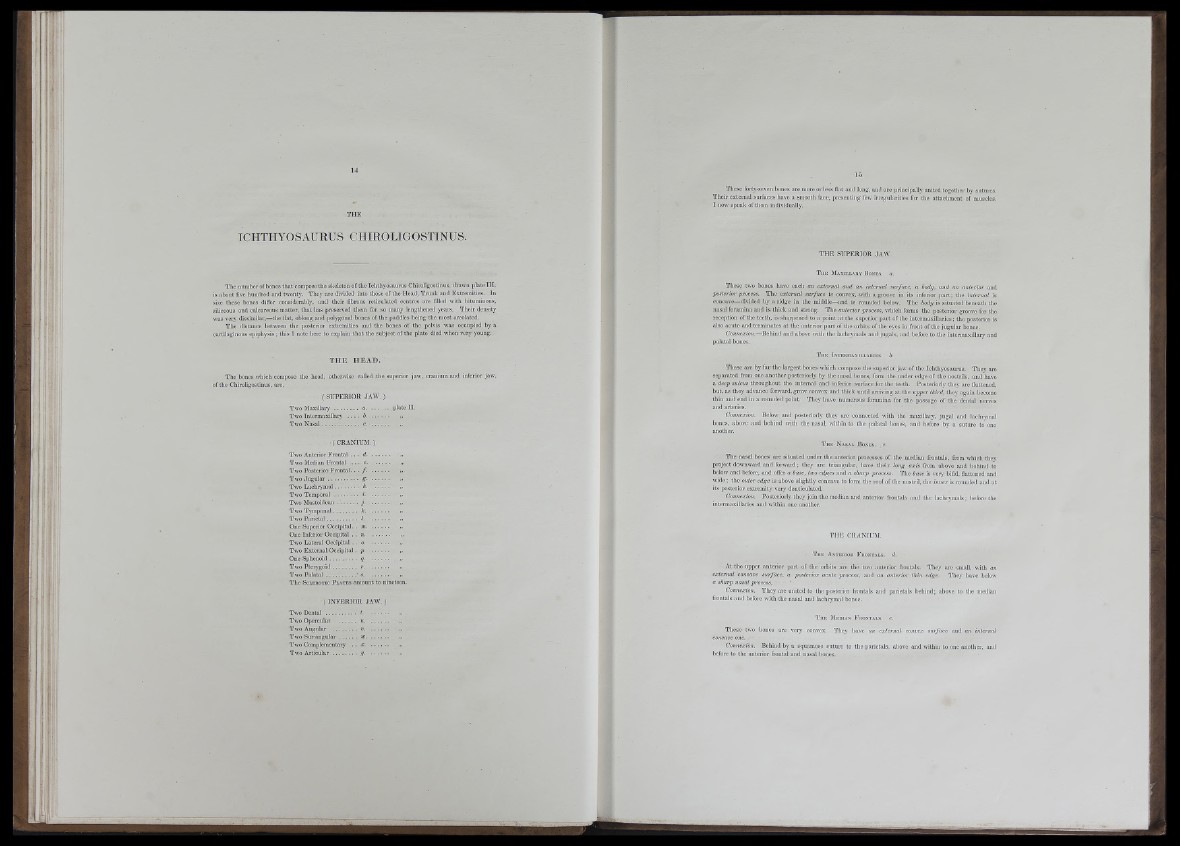
ICHTHYOSAURUS CHIROLIGOSTINUS.
Tlienumber of bones that compose tlie skeleton of the Ichthyosaurus Chiroligostinus, drawn plate III,
is about five hundred and twenty. They are divided into those of the Head, Triml? and Extremities. In
size these bones differ considerably, and tlieir fibrous reticulated centres arc filled witli bituminous,
siliceous and calcareous matter, that has preserved them for so many lengthened years. Their density
was very dissimilar,—the flat, oblong and polygonal bones of the paddles being the most arcolatcd.
Ttie distance between the posterior extremities and the bones of the pelvis was occupied by a
cartilaginous epiphysis ; this I note here to explain that the subject of the plate died when very young.
TH E H EA D .
The bones wliich compose the head, otherwise called the superior jaw, cranium and inferior jaw,
of the Chiroligostinus, are,
{ SUPERIOR JAW .)
Two Maxillary ............... a plate II.
Two Intermaxillary ----- b.......................
Two Na sa l....................... c...............
( CRANIUM, )
Two Anterior Frontal . . . d. .
Two Median Frontal .. . e.
Two Posterior Frontal. ■ ■ ■
Two Ju g u la r .............. g. ■
Two Lachiymal........... A.
Two Temporal ................ i- ■
Two Mastoidean.............. j . .
Two Tympanal................ k. .
Two Parietal.................... I. ■
One Superior Occipital.. m. .
One Inferior Occipital .. n. .
Two Lateral Occipital ,. o. .
Two External Occipital. p. .
One Sphenoid.................. q. •
Two P teiygoid................ r. .
Two P a la ta l...................• s. .
The Sclerotic P lates amount to nineteen.
( INFERIOR JAW .)
Two Dental ...............
Two Opercular -----
Two Angular ...........
Two Sur-angular . . . .
Two Complcmentaiy
Two Articular ..........
Those forty-seven bones are more or less Hal and long, and arc principally united togetlici- by sutures.
Their external surfaces have a smooth face, [ircsenting few irregularities for the attachment of muscles.
I now speak of tliem individually.
THE SUPERIOR JAW.
T he Maxillarv Bones.
These two bones have each an external and an internal surface, a body, and an aitlerior and
posterior process. The e.Ttemal surface is convex, with a groove in its inferior part; the internal is
concave—divided by a ridge in the middle—and is rounded below. Tlie body is situated beneath the
nasal foramina and is tliick and strong. The anterior process, whicli forms the posterior groove for the
reception of the teeth, is sharpened to a point at the superior part of tlie intcrmaxillaries; tho posterior is
also aeuto and terminates a t the anterior part of the orbits of the eyes in front of the jugular bones.
Conne.vion.—Beliincl and above witli the lachiymals and jugals, and before to the intermaxillaiy and
palatal bones.
T he Iktermaxillaries. b.
These are liy far the largest bones which compose the superior jaw of the Ichthyosaurus. They are
separated from one another posteriorly by the nasal bones, form the under edge of tlie nostrils, and iiavc
a deep .sulcus throughout tlie internal and inferior surface for the teeth. Posteriorly they are Ilattened,
but. as tliey advance forward, grow convex and thick until arriving at the upper third, they again become
thin and end in a rounded point. They have numerous foramina for the passage of the dental nerves
and arteries.
Connexio?i. Below and posteriorly they are connected witli the maxillary, jugal and lachrymal
bones, above and behind with the nasal, within to the palatal bones, and before by a suture to one
another.
T he N asal Boses, c.
The nasal bones arc situated under the anterior processes of the median frontals, from wliich they
project downward and forward; they are triangular, liave their long a.vis from above and behind to
below and before, and offer a base, two edges and a sharp process. Tlie base is veiy bifid, flattened and
wide; the outer edge is above slightly concave to form the roof of the nostril, the t?i7!er is rounded and at
its posterior extremity very denticulated,
Coiine.rio7i, Posteriorly they join the median and anterior frontals and the lachrymals; before the
intcrmaxillaries and within one another.
THE CRANIUM.
T he Anterior F rontals. d.
At the upper anterior part of tlie orbits are the two anterior frontals. They are small, with an
extenal concave surface, a posterior acute process, and an anterior thin edge. Tliey liave below
a sharp nasal process.
Comte.vion. They arc united to the posterior frontals and parietals behind; above to the median
frontals and before with the nasal and laclirymal bones.
T he Media.n F uo.stals. e.
These two bones arc very convex. They have an external coiivex surface and an internal
concave one.
Co«He.r(oii. Bcliind by a squamose suture to the parietals, aboi'e and within to one another, and
before to the anterior frontal and nasal bones.